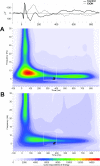Effects of adolescent ethanol exposure on event-related oscillations (EROs) in the hippocampus of adult rats
- PMID: 20170688
- PMCID: PMC2862110
- DOI: 10.1016/j.bbr.2010.02.021
Effects of adolescent ethanol exposure on event-related oscillations (EROs) in the hippocampus of adult rats
Abstract
Electrophysiological studies have shown that adolescent ethanol (EtOH) exposure can produce long-term changes in hippocampal EEG and ERP activity. Recently, evidence has emerged suggesting that event-related oscillations (EROs) may be good indices of alcoholism risk in humans, however, have not been evaluated for their ability to index the effects of EtOH exposure. The objective of the present study was to characterize EROs generated in hippocampus in adult rats exposed to EtOH during adolescence. Adolescent male Sprague-Dawley rats were exposed to EtOH vapor for 12h/d for 10 days. A time-frequency representation method was used to determine delta, theta, alpha and beta ERO energy and the degree of phase variation in the hippocampus of adult rats exposed to EtOH and age-matched controls. The present results suggest that the decrease in P3 amplitudes, previously observed in adult rats exposed to EtOH during adolescence, is associated with increases in evoked theta ERO energy. These studies suggest that EROs are suitable for characterizing the long-term effects of adolescent EtOH exposure. Further studies are needed to determine the relationship between the mechanisms that regulate these neurophysiological endophenotypes and the consequences of adolescent EtOH exposure.
Copyright 2010 Elsevier B.V. All rights reserved.
Figures


Similar articles
-
Electrophysiological effects of dizocilpine (MK-801) in adult rats exposed to ethanol during adolescence.Alcohol Clin Exp Res. 2008 Oct;32(10):1752-62. doi: 10.1111/j.1530-0277.2008.00760.x. Epub 2008 Jul 24. Alcohol Clin Exp Res. 2008. PMID: 18652596
-
Periadolescent alcohol exposure has lasting effects on adult neurophysiological function in rats.Brain Res Dev Brain Res. 2001 May 31;128(1):63-72. doi: 10.1016/s0165-3806(01)00150-x. Brain Res Dev Brain Res. 2001. PMID: 11356263
-
Effect of Gabapentin on Sleep and Event-Related Oscillations (EROs) in Rats Exposed to Chronic Intermittent Ethanol Vapor and Protracted Withdrawal.Alcohol Clin Exp Res. 2018 Mar;42(3):624-633. doi: 10.1111/acer.13588. Epub 2018 Jan 31. Alcohol Clin Exp Res. 2018. PMID: 29286538 Free PMC article.
-
Hippocampal function during adolescence: a unique target of ethanol effects.Ann N Y Acad Sci. 2004 Jun;1021:206-20. doi: 10.1196/annals.1308.026. Ann N Y Acad Sci. 2004. PMID: 15251891 Review.
-
Adolescent ethanol exposure: does it produce long-lasting electrophysiological effects?Alcohol. 2010 Feb;44(1):27-37. doi: 10.1016/j.alcohol.2009.09.033. Alcohol. 2010. PMID: 20113872 Free PMC article. Review.
Cited by
-
Event-related oscillations (ERO) during an active discrimination task: Effects of lesions of the nucleus basalis magnocellularis.Int J Psychophysiol. 2016 May;103:53-61. doi: 10.1016/j.ijpsycho.2015.02.010. Epub 2015 Feb 7. Int J Psychophysiol. 2016. PMID: 25660307 Free PMC article.
-
Alcohol drinking during adolescence increases consumptive responses to alcohol in adulthood in Wistar rats.Alcohol. 2017 Mar;59:43-51. doi: 10.1016/j.alcohol.2016.12.002. Epub 2017 Feb 7. Alcohol. 2017. PMID: 28187948 Free PMC article.
-
PSPH-D-18-00526: Effect of a dual orexin receptor antagonist (DORA-12) on sleep and event-related oscillations in rats exposed to ethanol vapor during adolescence.Psychopharmacology (Berl). 2020 Oct;237(10):2917-2927. doi: 10.1007/s00213-019-05371-4. Epub 2019 Oct 28. Psychopharmacology (Berl). 2020. PMID: 31659377 Free PMC article.
-
Use of a Fitbit-like device in rats: Sex differences, relation to EEG sleep, and use to measure the long-term effects of adolescent ethanol exposure.Alcohol Clin Exp Res (Hoboken). 2023 Jun;47(6):1055-1066. doi: 10.1111/acer.15079. Epub 2023 Jun 19. Alcohol Clin Exp Res (Hoboken). 2023. PMID: 37335518 Free PMC article.
-
Cholinergic modulation of event-related oscillations (ERO).Brain Res. 2014 Apr 22;1559:11-25. doi: 10.1016/j.brainres.2014.02.043. Epub 2014 Mar 2. Brain Res. 2014. PMID: 24594019 Free PMC article.
References
-
- Acheson SK, Richardson R, Swartzwelder HS. Developmental changes in seizure susceptibility during ethanol withdrawal. Alcohol. 1999;18:23–26. - PubMed
-
- Barron S, White A, Swartzwelder HS, Bell RL, Rodd ZA, Slawecki CJ, Ehlers CL, Levin ED, Rezvani AH, Spear LP. Adolescent vulnerabilities to chronic alcohol or nicotine exposure: findings from rodent models. Alcohol Clin Exp Res. 2005;29(9):1720–1725. - PubMed
-
- Basar E, Basar-Eroglu C, Karakas S, Schurmann M. Are cognitive processes manifested in event-related gamma, alpha, theta and delta oscillations in the EEG? Neurosci Lett. 1999;259(3):165–68. - PubMed
-
- Bauer LO, Hesselbrock VM. P300 decrements in teenagers with conduct problems: implications for substance abuse risk and brain development. Biol Psychiatry. 1999;46:263–272. - PubMed
-
- Begleiter H, Porjesz B. Genetics of human brain oscillations. Int J Psychophysiol. 2006;60(2):162–71. - PubMed
Publication types
MeSH terms
Substances
Grants and funding
LinkOut - more resources
Full Text Sources

